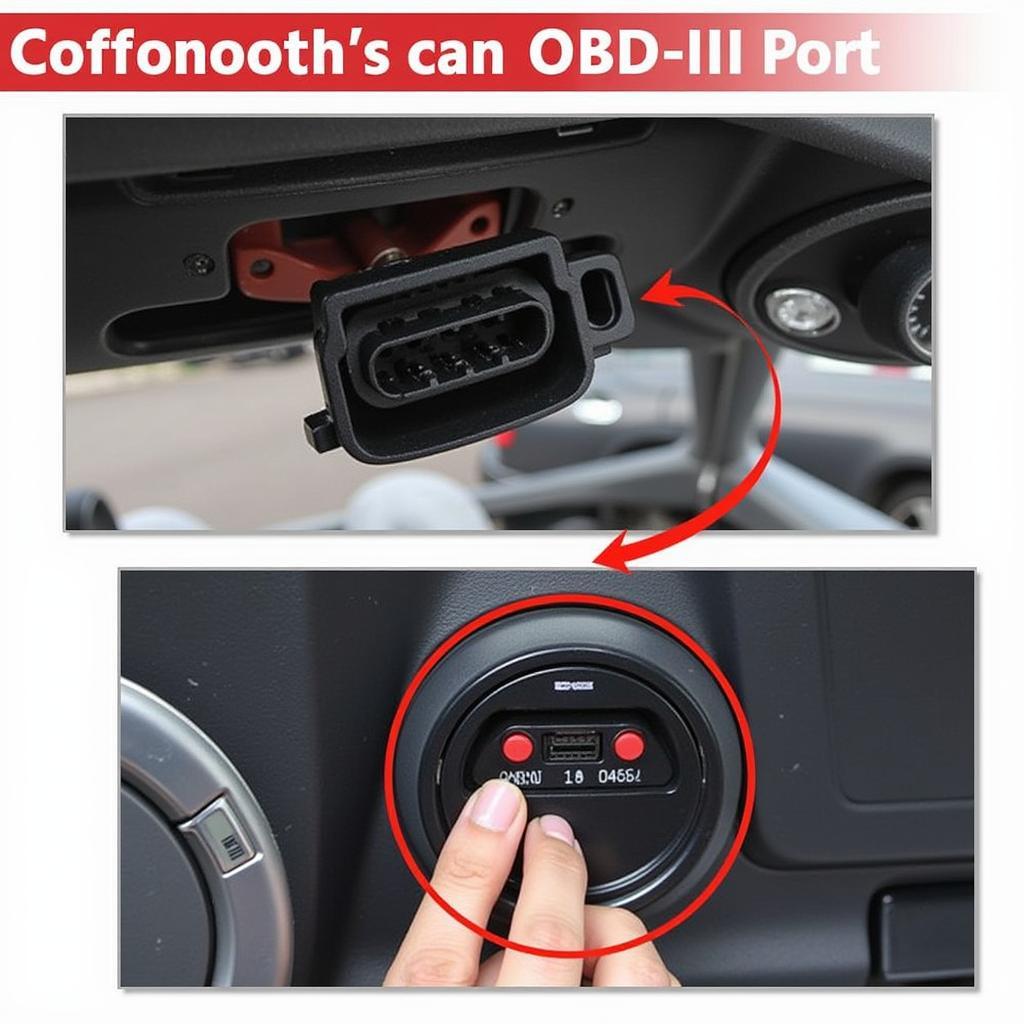The port in your car for a diagnostic tool is your gateway to understanding your vehicle’s health. It’s the connection point that allows a diagnostic tool, also known as a scan tool or code reader, to communicate with your car’s computer system and retrieve valuable information about its performance. But what exactly is this port, and why is it so important?
Understanding the OBD-II Port
Most modern vehicles (since 1996 in the US) are equipped with a standardized diagnostic port called the OBD-II port (On-Board Diagnostics, Second Generation). This 16-pin connector, usually located under the dashboard on the driver’s side, provides access to a wealth of data about your car’s engine, transmission, emissions system, and other critical components. Think of it as your car’s own personal translator, converting complex electronic signals into readable codes and data that can be interpreted by a diagnostic tool. Understanding the purpose of the port car for diagnostic tool is crucial for every car owner.
Knowing where to find portable car diagnostic tools is just as important as knowing how to use them. These handy tools empower you to diagnose car problems yourself, saving you time and money.
 OBD-II Port Location in a Car
OBD-II Port Location in a Car
Why is the Diagnostic Port Important?
The diagnostic port serves several crucial functions, making it an indispensable tool for both car owners and professional mechanics:
-
Retrieving Diagnostic Trouble Codes (DTCs): When something goes wrong with your car, the onboard computer system stores a DTC. A diagnostic tool connected to the OBD-II port can read these codes, providing valuable clues about the nature of the problem.
-
Monitoring Real-Time Data: The port allows you to access live data streams from various sensors throughout your vehicle. This information can help identify intermittent issues, monitor sensor performance, and gain a deeper understanding of your car’s operation. This is particularly useful when troubleshooting complex problems.
-
Performing Special Functions: Depending on the diagnostic tool and vehicle, the OBD-II port can be used to perform specific functions like resetting the check engine light, conducting emissions tests, and even programming new key fobs.
 Diagnostic Tool Connected to OBD-II Port
Diagnostic Tool Connected to OBD-II Port
If you’re looking for information on car diagnostic tool srs, understanding the OBD-II port is foundational knowledge. The SRS system relies on diagnostic codes accessible through this port.
What Type of Diagnostic Tool Do I Need?
There are several types of diagnostic tools available, ranging from basic code readers to advanced professional scan tools. The best tool for you depends on your needs and technical expertise.
-
Basic Code Readers: These affordable tools can read and clear DTCs, making them suitable for basic troubleshooting.
-
Enhanced Code Readers: These offer more features than basic code readers, including the ability to view live data and perform some special functions.
-
Professional Scan Tools: These powerful tools offer comprehensive diagnostic capabilities, including advanced functions like bidirectional control, waveform analysis, and programming.
For information on car diagnostic tool battery configuration, explore our dedicated resource page.
Troubleshooting Common OBD-II Port Issues
Sometimes, you might encounter issues with the OBD-II port itself. Common problems include a blown fuse, damaged connector pins, or communication errors.
“A common misconception is that all OBD-II ports are the same,” says automotive expert, Dr. Emily Carter. “While the physical connector is standardized, the communication protocols can vary slightly between different car makes and models. It’s essential to choose a diagnostic tool that’s compatible with your specific vehicle.”
Conclusion
The port in your car for a diagnostic tool, specifically the OBD-II port, is a vital component for understanding and maintaining your vehicle’s health. It allows you to access crucial information about your car’s performance, diagnose problems, and make informed decisions about repairs. By understanding the function and importance of this port, you can empower yourself to take control of your car’s maintenance and avoid costly surprises down the road. For those interested in tool list for car alarm installers, understanding the diagnostic port is crucial for effective installation and troubleshooting. Similarly, car trunk inlay tools can be essential for customizing your vehicle’s interior, but diagnosing any underlying electrical issues first is always recommended.
FAQ
- Where is the OBD-II port located? (Typically under the dashboard on the driver’s side)
- What does OBD-II stand for? (On-Board Diagnostics, Second Generation)
- Can I use any diagnostic tool with my car? (No, ensure compatibility with your car’s make and model)
- What are DTCs? (Diagnostic Trouble Codes)
- How can I fix a blown OBD-II port fuse? (Consult your car’s owner’s manual for fuse box location and replacement instructions)
- What if my diagnostic tool doesn’t communicate with my car? (Check for blown fuses, damaged connector pins, or compatibility issues)
- Can I damage my car by using a diagnostic tool? (Unlikely, unless you attempt to modify settings without proper knowledge)
Common Situations
- Check Engine Light On: The most common scenario prompting the use of a diagnostic tool.
- Car Won’t Start: Diagnostic tools can pinpoint potential issues like a faulty crankshaft sensor.
- Poor Fuel Economy: Identifying potential problems with the fuel system or oxygen sensors.
- Transmission Problems: Diagnosing issues like slipping gears or erratic shifting.
Further Exploration
For more information on related topics, you might find these articles helpful:
- How to Use a Diagnostic Tool
- Understanding Diagnostic Trouble Codes
- Common Car Problems and Their Solutions
Contact us for any assistance: WhatsApp: +1(641)206-8880, Email: [email protected] or address 910 Cedar Lane, Chicago, IL 60605, USA. We have a 24/7 customer support team.

Leave a Reply